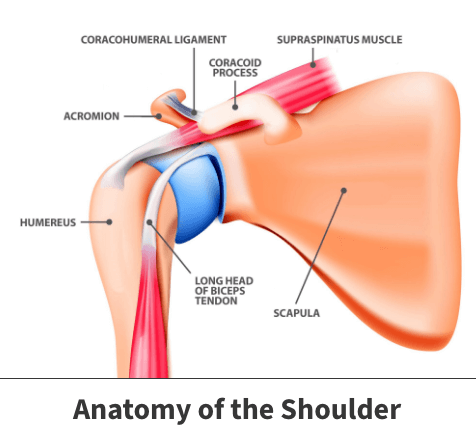Shoulder injury
Pain in the overhead athlete
Competing in sports requiring you to throw overhead can be challenging, healthy, and enjoyable. These activities can also stress your upper body significantly, causing shoulder pain. Shoulder discomfort is something to be aware of as it can indicate an injury.
Anatomy

The shoulder is a major joint connecting several bones. One of the main parts of the shoulder is the upper arm bone. This bone fits into your shoulder blade, creating an important connection to allow overhead throwing motions.
The shoulder’s primary parts are supported by other body parts that keep the bones and joints stable, such as:
- The shoulder socket – which fits certain shoulder bones
- The labrum – a thick tissue that protects the shoulder joint and socket
- The shoulder capsule – a collection of ligaments that keeps the upper arm bone firmly attached to the socket
- The rotator cuff – a group of muscles and tendons, which promotes shoulder stability
- The biceps muscle – attached to the shoulder blade by the biceps tendons
Several upper back muscles also play a crucial role in ensuring the shoulder joint’s stability.
About
When any of the shoulder components experience an injury such as inflammation or tears, you may have shoulder pain or instability.
Conditions capable of causing shoulder problems
Shoulder pain or instability might result from conditions including:
- Tendinitis
- Rotator cuff tears
- Labrum tears (medically known as SLAP injuries)
- Bicep muscle tears
- Impingement (when an injured shoulder presses against a neighboring part)
Over time, full-blown instability can occur. This happens when an injury has advanced to a stage where supporting tissues can no longer keep the upper arm completely attached to the socket.
Risk factors
Typically, significant shoulder injuries and possible instability result from participation in a sport that requires overhead throwing motions. Sports like volleyball, tennis, track and field, weightlifting, and other extreme competitions increase the risk.
Your chances are likely the highest as a baseball pitcher because pitching a baseball is one of the most unnatural movements your arm and shoulder can make.
These fast, forceful, violent motions cause a large percentage of significant shoulder injuries and associated instability incidents.

Symptoms
The symptoms you have will vary depending on the specific injury, its severity, and the part of the shoulder affected.
These injuries often produce common symptoms such as shoulder pain. In a shoulder injury’s early stages, this discomfort might be mild or only appear when engaging in an overhead throwing motion.
As the problem worsens, the pain might be more consistent and intense. Moderate to severe shoulder injuries may limit your ability to move or lift your arm. This injury can result in swelling and tenderness, numbness, or even the feeling that your shoulder is weakened or loose.
Complications
Shoulder pain lasting for any time or worsening should be examined by your doctor or orthopedic specialist as soon as possible. Failing to get a timely and accurate diagnosis could lead to more severe injury or instability and possibly even permanent disability.
Diagnosis
When you visit FOI with shoulder pain, your physician will ask about your symptoms, the timeline of when it started, and which, if any, sports you routinely take part in.
The examination’s next phase often involves performing various movements geared towards determining your pain threshold and your shoulder’s motion range.
Confirming injuries like tendinitis or muscle/tissue tears often need an X-ray, CT, MRI scan, or ultrasound.
Treatment
Mild to moderate injuries usually respond to non-surgical treatments. Surgery may be advised if you have sustained severe structural damage or significant instability.
Nonsurgical treatments
In many uncomplicated cases of shoulder pain, you might find relief by:
- Applying ice to the injured shoulder
- Taking over-the-counter or prescription inflammation-reducing or pain-alleviating medications
- Restricting athletic competition or any other actions placing unnecessary strain on your injured shoulder
- Receiving steroid injections
Physical therapy is another way to improve your condition. Designed in concert with your physician and administered by a physical therapist, physical therapy is designed to help you regain strength and mobility in your damaged shoulder.
Learn More About Physical Therapy
Surgical intervention
Severe instances or injuries not responding well to non-surgical therapies might warrant surgery. The operation can either be arthroscopic (less invasive) or open surgery (requiring larger incisions and longer recovery time).
Your doctor will recommend a specific procedure after considering:
- Your age
- Physical fitness level
- Overall health
- Your underlying problem and its severity
Following surgery, your shoulder’s mobility will be restricted for weeks using a device like a sling. This will promote the healing process and protect your shoulder from further injury. As you progress, you will have most likely have physical therapy prescribed.
Prevention
Preventing shoulder pain and associated injuries might not be possible for all athletes. You may reduce your risk by using stretching exercises. Learning proper throwing techniques can place less strain on your shoulder.
Prognosis
A large percentage of shoulder pain cases resolve in a few weeks after nonsurgical treatments. Following surgery, the pain usually lessens within two to four months. It could take up to a full year before you can return to previous athletic activities.
Videos
Related specialties
- AC Joint Injuries
- Atraumatic Shoulder Instability
- Bankart Repair
- Bicep Tenodesis
- Broken Collarbone
- Bursitis of the Shoulder (Subacromial Bursitis)
- Calcific Tendinitis of the Shoulder
- Clavicle Fractures
- Dislocated Shoulder
- Fractures of the Shoulder Blade (Scapula)
- Glenoid Labrum Tear
- Impingement Syndrome of the Shoulder
- Little League Shoulder
- Reverse Total Shoulder Replacement
- Rheumatoid Arthritis (RA) of the Shoulder
- Rotator Cuff Tears
- Shoulder Arthritis
- Shoulder Arthroscopy
- Shoulder Replacement
- Shoulder Separations
- Shoulder Socket Fracture (Glenoid Fracture)
- SLAP Tears & Repairs
- Subacromial Decompression
- Trapezius Strain (Muscle Strain Of The Upper Back)
- Traumatic Shoulder Instability
